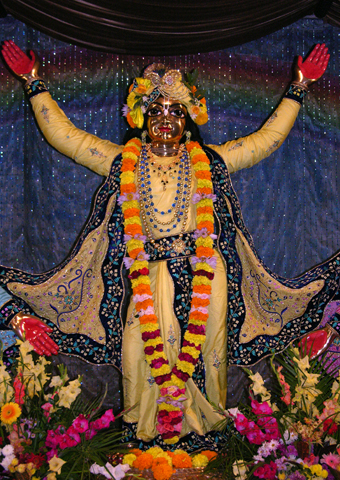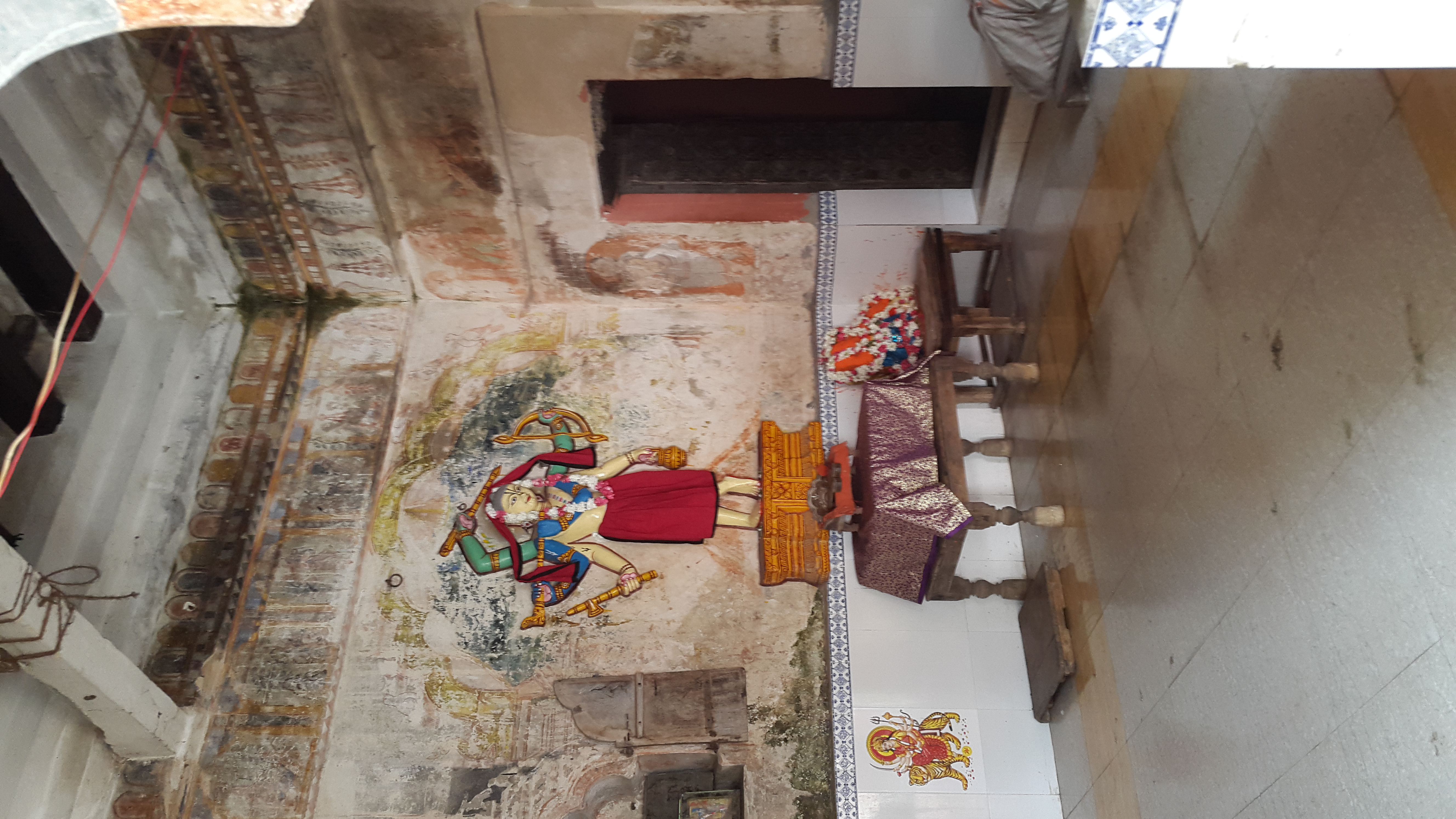|
Upadesamrta
The Upadesamrta, or Nectar of Instruction, is an important Gaudiya Vaishnava spiritual text, composed by Rupa Goswami. The Upadesamrta was translated into English in its entirety by A. C. Bhaktivedanta Swami Prabhupada, founder acarya of the International Society for Krishna Consciousness. Prabhupada also gives extensive commentaries on each translated verse within the Upadesamrita. In the Nectar of Instruction, Prabhupada writes "The Kṛṣṇa consciousness movement is conducted under the supervision of Śrīla Rūpa Gosvāmī. The Gauḍīya Vaiṣṇavas, or Bengali Vaiṣṇavas, are mostly followers of Śrī Caitanya Mahāprabhu, of whom the six Gosvāmīs of Vṛndāvana are direct disciples. Therefore Śrīla Narottama dāsa Ṭhākura has sung: ''rūpa-raghunātha-pade ha-ibe ākuti'' ''kabe hāma bujhaba se yugala-pīriti'' 'When I am eager to understand the literature given by the Gosvāmīs, then I shall be able to understand the transcendental loving affairs of ... [...More Info...] [...Related Items...] OR: [Wikipedia] [Google] [Baidu] |
Rupa Goswami
Rupa Goswami ( sa, रूप गोस्वामी, bn, রূপ গোস্বামী, ; 1489–1564) was a devotional teacher (guru), poet, and philosopher of the Gaudiya Vaishnava tradition. With his brother Sanatana Goswami, he is considered the most senior of the six Goswamis of Vrindavan associated with Caitanya Mahaprabhu, a hidden avatar (incarnation) of Krishna in Kali Yuga. Biography Genealogy His family lineage can be traced to Indian State of Karnataka and Naihati in the district of North 24 Parganas in present-day West Bengal, India. The former generations according to ''Bhakti-ratnakara'': Sarvajna Jagatguru was a famous brahmana, great scholar in all Vedas, respected Yajur-vedi of the Baradvaja caste, and king of Karnataka in South India, adored by all other contemporary kings. Sarvajna's son, Aniruddha, was spirited, famous, a proficient scholar of the Vedas, and a favorite of the reigning kings at the time. Aniruddha's sons, Rupesvara (eldest) and H ... [...More Info...] [...Related Items...] OR: [Wikipedia] [Google] [Baidu] |
Rūpa Gosvāmī
Rupa Goswami ( sa, रूप गोस्वामी, bn, রূপ গোস্বামী, ; 1489–1564) was a devotional teacher ( guru), poet, and philosopher of the Gaudiya Vaishnava tradition. With his brother Sanatana Goswami, he is considered the most senior of the six Goswamis of Vrindavan associated with Caitanya Mahaprabhu, a hidden avatar (incarnation) of Krishna in Kali Yuga. Biography Genealogy His family lineage can be traced to Indian State of Karnataka and Naihati in the district of North 24 Parganas in present-day West Bengal, India. The former generations according to ''Bhakti-ratnakara'': Sarvajna Jagatguru was a famous brahmana, great scholar in all Vedas, respected Yajur-vedi of the Baradvaja caste, and king of Karnataka in South India, adored by all other contemporary kings. Sarvajna's son, Aniruddha, was spirited, famous, a proficient scholar of the Vedas, and a favorite of the reigning kings at the time. Aniruddha's sons, Rupesvara (eld ... [...More Info...] [...Related Items...] OR: [Wikipedia] [Google] [Baidu] |
Gaudiya Vaishnava
Gaudiya Vaishnavism (), also known as Chaitanya Vaishnavism, is a Vaishnava Hindu religious movement inspired by Chaitanya Mahaprabhu (1486–1534) in India. "Gaudiya" refers to the Gaura or Gauḍa region of Bengal, with Vaishnavism meaning "the worship of Vishnu". Specifically, it is part of Krishnaism—Krishna-centric Vaishnavite traditions. Its theological basis is primarily that of the ''Bhagavad Gita'' and ''Bhagavata Purana'' (known within the tradition as the ''Srimad Bhagavatam''), as interpreted by early followers of Chaitanya, such as Sanatana Goswami, Rupa Goswami, Jiva Goswami, Gopala Bhatta Goswami and others. The focus of Gaudiya Vaishnavism is the devotional worship (known as bhakti yoga) of Radha and Krishna, and their many divine incarnations as the supreme forms of God, '' Svayam Bhagavan''. Most popularly, this worship takes the form of singing Radha and Krishna's holy names, such as "Hare", "Krishna" and "Rama", most commonly in the form of the Hare ... [...More Info...] [...Related Items...] OR: [Wikipedia] [Google] [Baidu] |
Acarya
In Indian religions and society, an ''acharya'' (Sanskrit: आचार्य, IAST: ; Pali: ''ācariya'') is a preceptor and expert instructor in matters such as religion, or any other subject. An acharya is a highly learned person with a title affixed to the names of learned subject. The designation has different meanings in Hinduism, Buddhism and secular contexts. ''Acharya'' is sometimes used to address an expert teacher or a scholar in any discipline, e.g.: Bhaskaracharya, the expert mathematician. Etymology The Sanskrit phrase ''Acharam Grahayati Acharam Dadati Iti Va'' means ''Acharya'' (or teacher) is the one who teaches good conduct to one's students. A female teacher is called an ''achāryā,'' and a male teacher's wife is called an ''achāryāni'' In Hinduism In Hinduism, an ''acharya'' is a formal title of a teacher or guru, who has attained a degree in Veda and Vedanga. Prominent acharyas in the Hindu tradition are as given below : *Adi Sankaracharya *Ramanu ... [...More Info...] [...Related Items...] OR: [Wikipedia] [Google] [Baidu] |
International Society For Krishna Consciousness
The International Society for Krishna Consciousness (ISKCON), known Colloquialism, colloquially as the Hare Krishna movement or Hare Krishnas, is a Gaudiya Vaishnavism, Gaudiya Vaishnava Hinduism, Hindu religious organization. ISKCON was founded in 1966 in New York City by A. C. Bhaktivedanta Swami Prabhupada. Its core beliefs are based on Hindu texts, Hindu scriptures, particularly the ''Bhagavad Gita'' and the ''Bhagavata Purana''. ISKCON is "the largest and, arguably, most important branch" of Gaudiya Vaishnava tradition, which has had adherents in India since the early 16th century and American and European Hindu devotional movements, devotees since the early 1900s. ISKCON was formed to spread the practice of Bhakti yoga, the practice of love of God in which those involved (''bhaktas'') dedicate their thoughts and actions towards pleasing Krishna, whom they consider the Svayam Bhagavan, Supreme Lord. Its most rapid expansion in membership have been within India and (after t ... [...More Info...] [...Related Items...] OR: [Wikipedia] [Google] [Baidu] |
Caitanya Mahāprabhu
Chaitanya Mahaprabhu (; born Vishvambhar Mishra) was a 15th-century Indian saint who is considered to be the combined avatar of Radha and Krishna by his disciples and various scriptures. Chaitanya Mahaprabhu's mode of worshipping Krishna with ecstatic song and dance had a profound effect on Vaishnavism in Bengal. He was also the chief proponent of the Vedantic philosophy of Achintya Bheda Abheda Tattva. Mahaprabhu founded Gaudiya Vaishnavism ( the Brahma-Madhva-Gaudiya Sampradaya). He expounded Bhakti yoga and popularized the chanting of the Hare Krishna Maha-mantra. He composed the ''Shikshashtakam'' (eight devotional prayers). Chaitanya is sometimes called Gauranga or Gaura due to his molten gold–like complexion. His birthday is celebrated as Gaura-purnima. He is also called Nimai due to him being born underneath a Neem tree. Life ''Chaitanya'' means "one who is conscious" (derived from Chetana, which means "Consciousness"); ''Maha'' means "Great" and ''P ... [...More Info...] [...Related Items...] OR: [Wikipedia] [Google] [Baidu] |
Vṛndāvana
Vrindavan (; ), also spelt Vrindaban and Brindaban, is a historical city in the Mathura district of Uttar Pradesh, India. It is located in the Braj Bhoomi region and holds religious importance in Hinduism as Krishna spent most of his childhood days in this city. Vrindavan has about 5,500 temples dedicated to the worship of Krishna and his divine consort Radha. It is one of the most sacred places for Vaishnavism tradition. Vrindavan is a significant part of the "Krishna pilgrimage circuit" which also includes Mathura, Barsana, Gokul, Govardhan, Kurukshetra, Dwarka and Puri. Etymology The ancient Sanskrit name of the city, (), comes from its groves of ''vṛndā'' (Holy basil) and ''vana'' (a grove or forest). Geography Vrindavan is located at . It has an average elevation of 170 metres (557 feet). Yamuna river flows through the city. It is located 125 km away from Delhi and 15 km away from Mathura City. Climate Demographics As of 2011 In ... [...More Info...] [...Related Items...] OR: [Wikipedia] [Google] [Baidu] |
Rādhā
Radha ( sa, राधा, ), also called Radhika, is a Hindu goddess and the chief consort of the god Krishna. She is worshiped as the goddess of love, tenderness, compassion, and devotion. She is the avatar of goddess Lakshmi and is also described as the chief of the '' Gopis'' (milkmaids). During Krishna's youth, she appears as his lover and companion. Many traditions and scriptures accord Radha the status of the eternal consort and wife of Krishna. Radha, as a supreme goddess, is considered as the female counterpart and the internal potency (''hladini shakti'') of Krishna, who resides in Goloka, the celestial abode of Radha Krishna. Radha is said to accompany Krishna in all his incarnations. In Radha Vallabh Sampradaya and Haridasi Sampradaya, only Radha is worshiped as the supreme deity. Elsewhere, she is venerated with Krishna as his principal consort in Nimbarka Sampradaya, Pushtimarg, Mahanam Sampraday, Swaminarayan Sampradaya, Vaishnava-Sahajiya and Gaudiya ... [...More Info...] [...Related Items...] OR: [Wikipedia] [Google] [Baidu] |
Kṛṣṇa
Krishna (; sa, कृष्ण ) is a major deity in Hinduism. He is worshipped as the eighth avatar of Vishnu and also as the Supreme god in his own right. He is the god of protection, compassion, tenderness, and love; and is one of the most popular and widely revered among Indian divinities. Krishna's birthday is celebrated every year by Hindus on Krishna Janmashtami according to the lunisolar Hindu calendar, which falls in late August or early September of the Gregorian calendar. The anecdotes and narratives of Krishna's life are generally titled as ''Krishna Leela''. He is a central character in the ''Mahabharata'', the ''Bhagavata Purana'', the ''Brahma Vaivarta Purana,'' and the ''Bhagavad Gita'', and is mentioned in many Hindu philosophical, theological, and mythological texts. They portray him in various perspectives: as a god-child, a prankster, a model lover, a divine hero, and the universal supreme being. Quote: "Krsna's various appearances as a divine her ... [...More Info...] [...Related Items...] OR: [Wikipedia] [Google] [Baidu] |
Gaudiya Vaishnavism
Gaudiya Vaishnavism (), also known as Chaitanya Vaishnavism, is a Vaishnava Hindu religious movement inspired by Chaitanya Mahaprabhu (1486–1534) in India. "Gaudiya" refers to the Gaura or Gauḍa region of Bengal, with Vaishnavism meaning "the worship of Vishnu". Specifically, it is part of Krishnaism—Krishna-centric Vaishnavite traditions. Its theological basis is primarily that of the ''Bhagavad Gita'' and ''Bhagavata Purana'' (known within the tradition as the ''Srimad Bhagavatam''), as interpreted by early followers of Chaitanya, such as Sanatana Goswami, Rupa Goswami, Jiva Goswami, Gopala Bhatta Goswami and others. The focus of Gaudiya Vaishnavism is the devotional worship (known as bhakti yoga) of Radha and Krishna, and their many divine incarnations as the supreme forms of God, '' Svayam Bhagavan''. Most popularly, this worship takes the form of singing Radha and Krishna's holy names, such as " Hare", "Krishna" and "Rama", most commonly in the form of the Ha ... [...More Info...] [...Related Items...] OR: [Wikipedia] [Google] [Baidu] |





